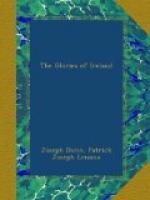Nor has the love of the Irish for religion, any more than their love of learning, been lessened or enfeebled by time. The mountain side as the place for Mass in the penal days gradually gave way to the rude stone church without steeple or bell; and when steeple and bell ceased to be proscribed, and the people were left free to erect suitable houses of sacrifice and prayer, the fine churches of the nineteenth century began gradually to appear. The unfettered exercise of freedom of religious worship, the untiring efforts of a zealous clergy and episcopate, the unstinted support of a people, who out of their poverty grudged nothing to God or to God’s house, formed an irresistible combination, and all over the country beautiful churches are now to be found.
In every diocese in Ireland, with scarcely an exception, there is now a stately cathedral to perpetuate the renown of the patron saint of that diocese, and even parish churches have been built not unworthy to be the churches of an ancient see. At Armagh, a cathedral has been built which does honor to Irish architecture, and worthily commemorates the life and labors of St. Patrick, the founder of the primatial see; at Thurles, a cathedral stands, the chief church of the southern province, statelier far than any which ever stood on the Rock of Cashel; at Tuam, a noble building, associated with the memory of John MacHale, the Lion of the Fold of Judah, perpetuates the name of St. Jarlath; at Queenstown, the traveller, going to America or returning from it to the old land, has his attention attracted to the splendid cathedral pile sacred to St. Colman, the patron saint of the diocese of Cloyne; and if we would see how splendid even a parish church may be, let us visit the beautiful church in Drogheda, dedicated to the memory of Oliver Plunkett.
Nor are these things the only evidence we have that zeal for religion among the Irish has survived centuries of persecution. Columbanus and Columcille have still their successors, eager and ready as they were to bring the blessings of the Gospel to distant lands. In recent years an Irish-born Archbishop of Sydney has been succeeded by an Irish-born Archbishop; an Irishman rules the metropolitan see of Adelaide; and an Irish-born Archbishop of Melbourne has as his coadjutor a former president of the College of Maynooth. In South Africa, the work of preaching and teaching and ruling the church is largely the work of Irish-born men. In the great Republic of the West the three cardinal-archbishops at the head of the Catholic Church have the distinctively Irish names of Gibbons and Farley and O’Connell; and in every diocese throughout the United States the proportion of priests of Irish birth or descent is large.




